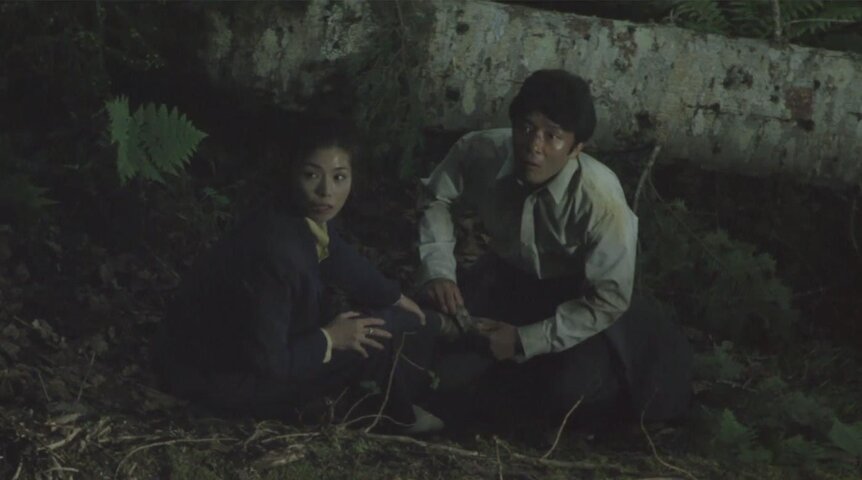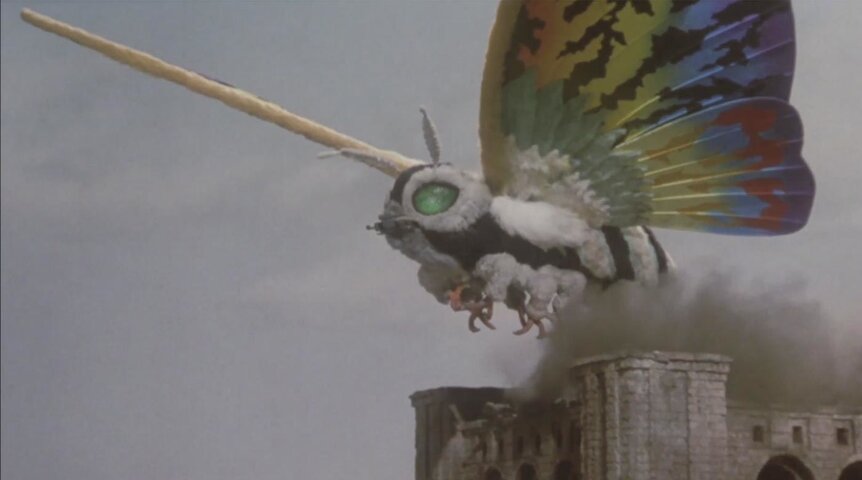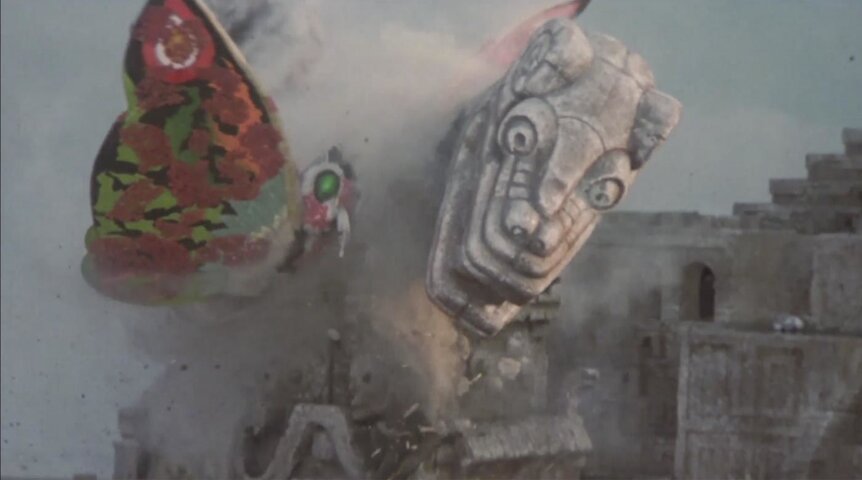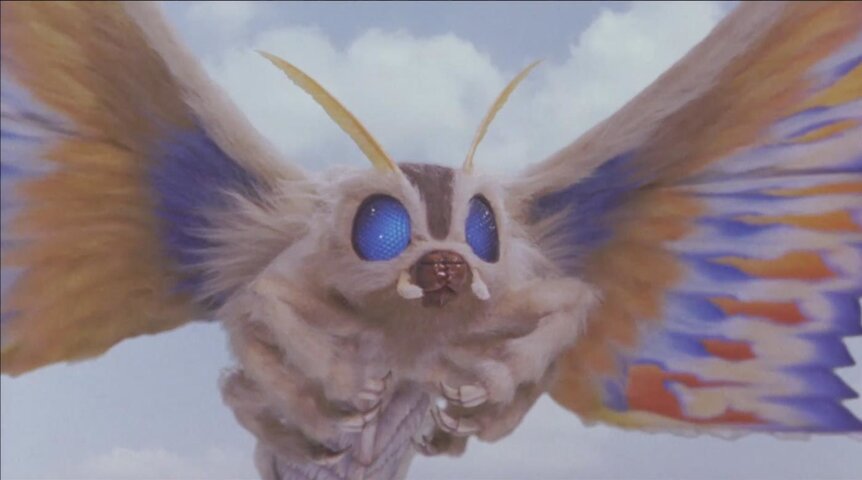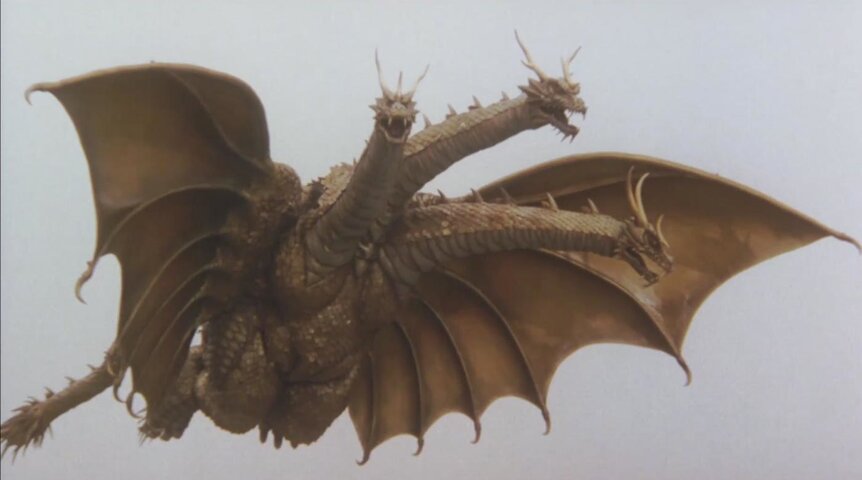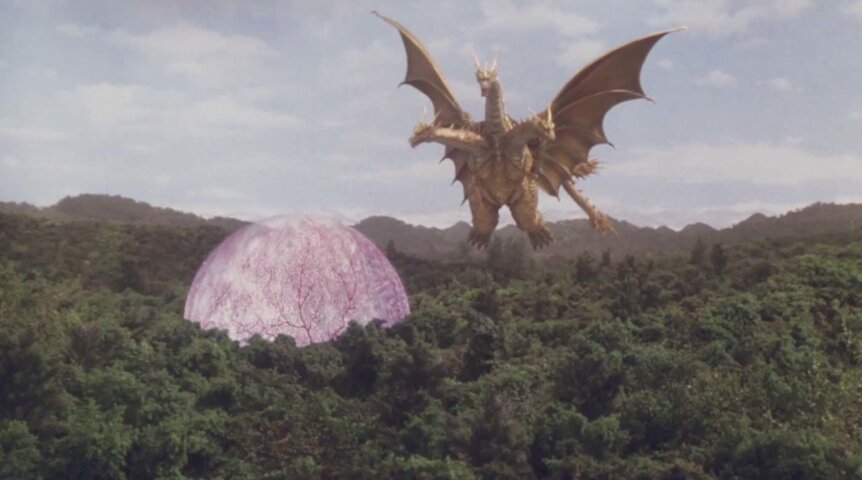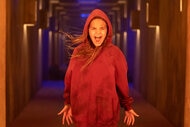Create a free profile to get unlimited access to exclusive videos, sweepstakes, and more!
The '90s Mothra trilogy was trippy, kiddie, and criminally underrated

One of the most ubiquitous monsters in Japanese science fiction, Mothra was first inducted into pop culture when Toho producer Tomoyuki Tanaka commissioned a trio of authors to pen a serialized novel about a giant insect. The completed novel served as the basic groundwork for a feature-length 1961 movie directed by Ishiro Honda, which in turn became a great success in Japan as well as internationally. Three years later, Toho brought Mothra back and pitted her against Godzilla for the first time. The character has been a recurring monster in the Godzilla franchise ever since and will soon be making its Hollywood debut in the forthcoming Michael Dougherty-directed Godzilla: King of the Monsters from Legendary Pictures.
Despite its reputation as a common foe (and sometimes ally) to Godzilla, there were a couple of instances in which Mothra broke away and held the lead in a movie under its own name. Besides the 1961 film, Mothra had a trilogy in the 1990s, known stateside as the Rebirth of Mothra trilogy. Produced in the aftermath of the Heisei Godzilla series, these three films were made with families — children in particular — in mind first and foremost. And while Godzilla does not appear in any of them, two of the films feature incarnations of Ghidorah (who will also be appearing in Godzilla: King of the Monsters), and all three contain special effects by some of the most prominent SFX directors in kaiju eiga.
SHORT ON STORY, BUT SATISFYING
Rebirth of Mothra (1996) follows ostensibly in the aesthetic footsteps of the phenomenally profitable Godzilla vs. Mothra (1992), assuming a lighthearted tone and placing heavy emphasis on fantasy and environmental issues. It begins with a deforestation project (allegedly inspired by a controversial proposed logging operation in Shiretoko National Park in the 1980s), which unearths the tomb of Desghidorah, an extra-terrestrial monster who came to Earth millions of years ago and was subsequently buried by Mothra and an ancient race of miniature people called the Elias.
Unfortunately, Mothra is nearing the end of her natural lifespan and only three Elias remain. On top of that, one of the Elias fairies, Belvera, has plans to use Desghidorah for world domination. And only her (good) sisters, Moll and Lora, who have the ability to summon Mothra, can get in her way.
In what somewhat recalls 1992's Godzilla vs. Mothra, the human element revolves around a family with parents who don't exactly get along the best. The father's employed in the Forestry Agency and spends a lot of time away from home to the dismay of his wife, who would rather he be with her and their two children. One night, the father comes home with the seal of Desghidorah's tomb, which he gives to his daughter as a present. This attracts the attention of Belvera and her two sisters, and the family becomes mixed up in a race to save the world.
Desghidorah inevitably awakens and it's up to Mothra, old and frail as she is, to fight him. However, she's not alone: Mothra's offspring prematurely hatches from his egg and swims across the sea to join his mother in battle.
Of the three films in the trilogy, Rebirth of Mothra is the most consistent and enjoyable. While it ultimately feels more like a special effects show than a full-fledged piece of storytelling, it is well-crafted and fast-moving enough to make for an enjoyable piece of lightweight entertainment. First-time director Okihiro Yoneda does a decent enough job streamlining the human scenes so that the monster action begins relatively soon and works efficiently with cinematographer Yoshinori Sekiguchi in showing off the beautiful forested areas in which much of the film takes place.
He also manages to achieve some touching (albeit much too brief) moments with the parents. In one such moment, the mother sprains her ankle in the forest and her husband promptly uses his tie to set her injury. Little moments like these leave one wishing the parents had been the focus of the drama (instead of their children, who get much more screentime), and the performances by Kenjiro Nashimoto and Hitomi Takahashi — two of the better young actors in Toho's '90s special effects movies — sell the illusion of a couple who still love one another in spite of their differences.
Koichi Kawakita had done the special effects for the Godzilla movies of the '90s and again is placed in charge of bringing monsters to life. His puppetry for the adult Mothra is, in some ways, an improvement over its 1992 counterpart, not as well-sculpted but exhibiting a superior range of movement with actively mobile legs and some improved aerial movement. In one impressive wide shot, Mothra gets hit by Desghidorah's rays and visibly jerks and spasms, trying desperately to remain aloft. Kawakita's puppetry for the larvae Mothra is even better, bringing back the elegant undulation that had been sorely lacking in the '92 film. And as a villain, Desghidorah is a feast for the eyes: Resembling a European dragon in design, with a convincing sense of mass, and walking on four legs instead of two.
Rebirth of Mothra delivers in the long run with some very satisfying if formulaic monster action (Kawakita, alas, tended to rely too much on animated beams instead of balancing it with physical combat). But the film ultimately stumbles in delivering its environmentalism message. In the wake of Desghidorah's defeat, the once lush Japanese countryside has been burned to the ground and the characters somberly pontificate on how they must try to learn from the past and create a better world for future generations, only to have Mothra's son (now an adult) fly over and magically resuscitate the forest. What could've been a challenging ending ultimately downplays the picture's theme to what feels more like a forced afterthought than a sincere message.
HITTING ROCK BOTTOM
After Rebirth of Mothra proved lucrative at the Japanese box office, production on a sequel went into action. In what recalls the Showa Gamera movies of the late '60s, the second film shifts its emphasis to child protagonists, with adults now portrayed as bumbling simpletons prone to slapstick and other pratfalls. Most prominent is an Indiana Jones-esque adventure element as the children, their adult pursuers, and the Elias navigate an ancient pyramid that has risen from the ocean.
However, instead of an enjoyable adventure movie, Rebirth of Mothra II (1997) proves to be one of the most mind-numbing films ever spat out by Toho: A dreadful production compounding the flaws of its predecessor while retaining virtually none of its finer qualities.
New director Kunio Miyoshi, who had never made a film before and unsurprisingly hasn't made one since, takes the fourth-rate script (loaded with unlikable characters, plot holes, and a halfhearted anti-pollution theme) and does it no favors. Every scene feels awkwardly staged and mercilessly padded out, and the director's attempts at humor (mostly dull buildups to something strange before cutting away to an exterior shot as someone screams) fall flat at every turn.
Making matters worse is his handling of actors. The characters from the first Rebirth of Mothra were nothing to write home about, but at their worst they were forgettable and there were at least a few decent performances. By contrast, the protagonists of Rebirth of Mothra II are actively annoying with unctuous acting from everyone, young and old, child and adult. No one emerges from this picture looking good.
Even the special effects sequences come up short. Mothra's new opponent is a pollution-devouring sea beast called Dagahra. A unique monster with an appreciably subtle design, and having Mothra (an aerial monster) fighting a water-based creature is certainly interesting in theory. But with the exception of a mid-movie battle with the creatures waging war from the sea to a lake (Dagahra often using his watery surroundings to his advantage), the monster action is dull and rather lacking. And the finale, in which Mothra transforms into an aquatic form and divides into a swarm of tiny Mothras to swim down Dagahra's throat leads to one of the ugliest-looking CGI moments ever spawned in a Japanese special effects picture.
To be fair, Kawakita manages a few fleeting bits of impressive monster action, including a great moment in which Dagahra smashes Mothra into a stone statue on the edge of the pyramid and sends both tumbling into the sea. The score by Toshiyuki Watanabe is wonderful (far better than this film deserves).
And Rebirth of Mothra II must be given credit for introducing two storytelling elements that would remain relevant for the third entry in the trilogy: Belvera's change of heart (saving the other characters from a fiery death) and the concept of Mothra changing form for new combat situations. But these aspects cannot even begin to make up for the picture's countless other faults and prevent it from becoming one of the two or three most painfully unenjoyable special effects movies in the annals of Toho.
A DECENT BOUNCE BACK
Rebirth of Mothra II didn't rake in as much money as its predecessor, but it still managed to place in the year's top 10 box office draws — coming in at No. 8 — and so a concluding entry for the trilogy came to be. This new film saw the return of director Okihiro Yoneda as well as a change of power in the special effects department.
Koichi Kawakita had retired from film work the previous year, and so the reins were handed over to his assistant, Kenji Suzuki, who went on to provide a breath of fresh air not only for the third Rebirth of Mothra but for Toho special effects cinema in general. After this film, Suzuki would helm the effects for Godzilla 2000 and Godzilla vs. Megaguirus, all the while exhibiting an uneven but visually striking and at times rather daring aesthetic.
In contrast to the work of his mentor in the first two films, Suzuki's monster action in Rebirth of Mothra III (1998) presents a satisfying blend of projectile-based attacks and physical combat as Mothra goes up against not one but two incarnations of King Ghidorah (both harkening back to the classic, two-legged design).
The combatants crash into one another, biting and clawing (at one point, Ghidorah uses his three mouths to violently tear out chunks of Mothra's wings), resulting in a savage melee to the death. Mothra also takes on several forms throughout the film, including an impressively designed armored form with bladed wings used to slash through adversaries.
Unfortunately, Suzuki's handling of the Mothra puppetry isn't that much of an improvement over Kawakita's. While the wing movement is considerably more organic, the puppet's head and legs are absurdly stiff; and when Mothra is resting on the ground, the prop quite often doesn't move at all. (In similar scenes from the first two movies, Kawakita would at least employ some movement in the antennae and mouth to maintain the illusion of Mothra being a living creature.)
Similar to the effects, the story of Rebirth of Mothra III is both better and weaker than that of the first movie. While the characters are a bit more active and don't simply walk around in the background while the monsters wage war (not to mention there are more personal stakes with King Ghidorah capturing relatives of the protagonists and threatening to devour them), none of them are especially interesting; and the actors don't evoke nuances like the parents in the first Rebirth of Mothra.
On the plus side, incorporating the three Elias fairies so they do more than just summon Mothra is a nice touch, and advancing the second film's narrative device from Belvera having a change of heart to siding with her sisters is similarly welcome. Ultimately, the movie is a little too slow-going to match the entertainment value of the first entry in the series but still makes for a colossal improvement over the trilogy's abominable second film.
Rebirth of Mothra III was the least profitable of the three movies but still managed to break the top 10, rounding out a fiscally profitable if qualitatively uneven (and never spectacular) trilogy of Mothra films.
The views and opinions expressed in this article are the author's, and do not necessarily reflect those of SYFY WIRE, SYFY, or NBC Universal.

